Organisational Capacity Building: A Case Study of Whitlam Hospital
VerifiedAdded on 2023/06/14
|8
|2216
|461
Essay
AI Summary
This essay provides an analysis of the organisational structure of Whitlam Memorial Hospital (WMH), a 130-bed community hospital in Sydney undergoing expansion and service diversification. It begins by outlining the strengths and weaknesses of WMH's current traditional bureaucratic structure, highlighting its administrative control benefits but also its limitations in employee satisfaction and adaptability. The essay then discusses the importance of organisational vision, mission, and objectives in aligning organisational functions and strategy, emphasizing their role in guiding employee focus and reducing errors. It proposes a shift towards a flatter or hybrid organisational structure to foster greater employee involvement in decision-making, enhance creativity, and improve responsiveness to patient needs. While acknowledging the potential drawbacks of such a structure, like slower decision-making and potential conflicts, the essay concludes that a flat structure would empower frontline staff and promote leadership growth within WMH. The document is contributed by a student and available on Desklib, a platform offering study tools and resources.
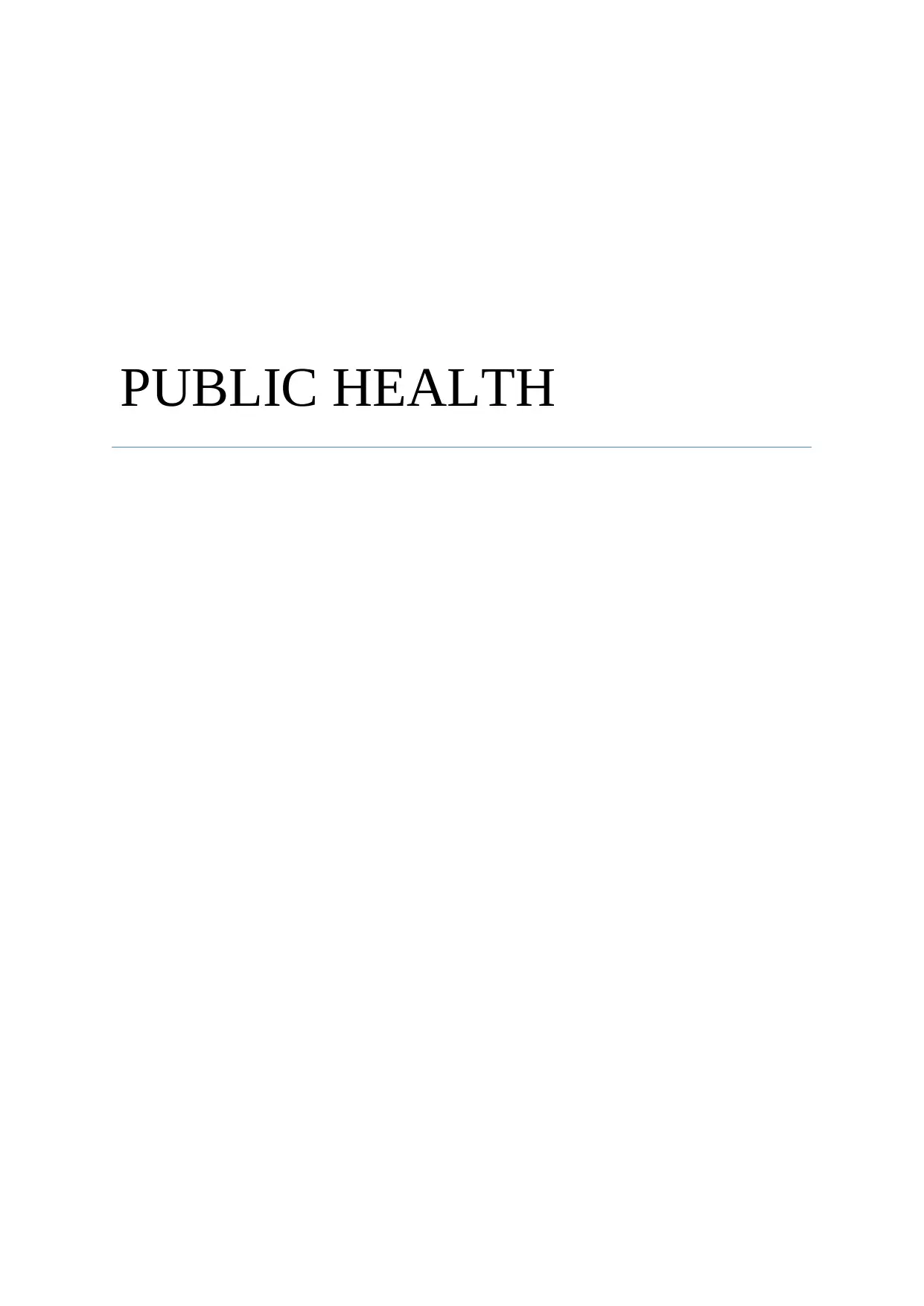
PUBLIC HEALTH
Paraphrase This Document
Need a fresh take? Get an instant paraphrase of this document with our AI Paraphraser
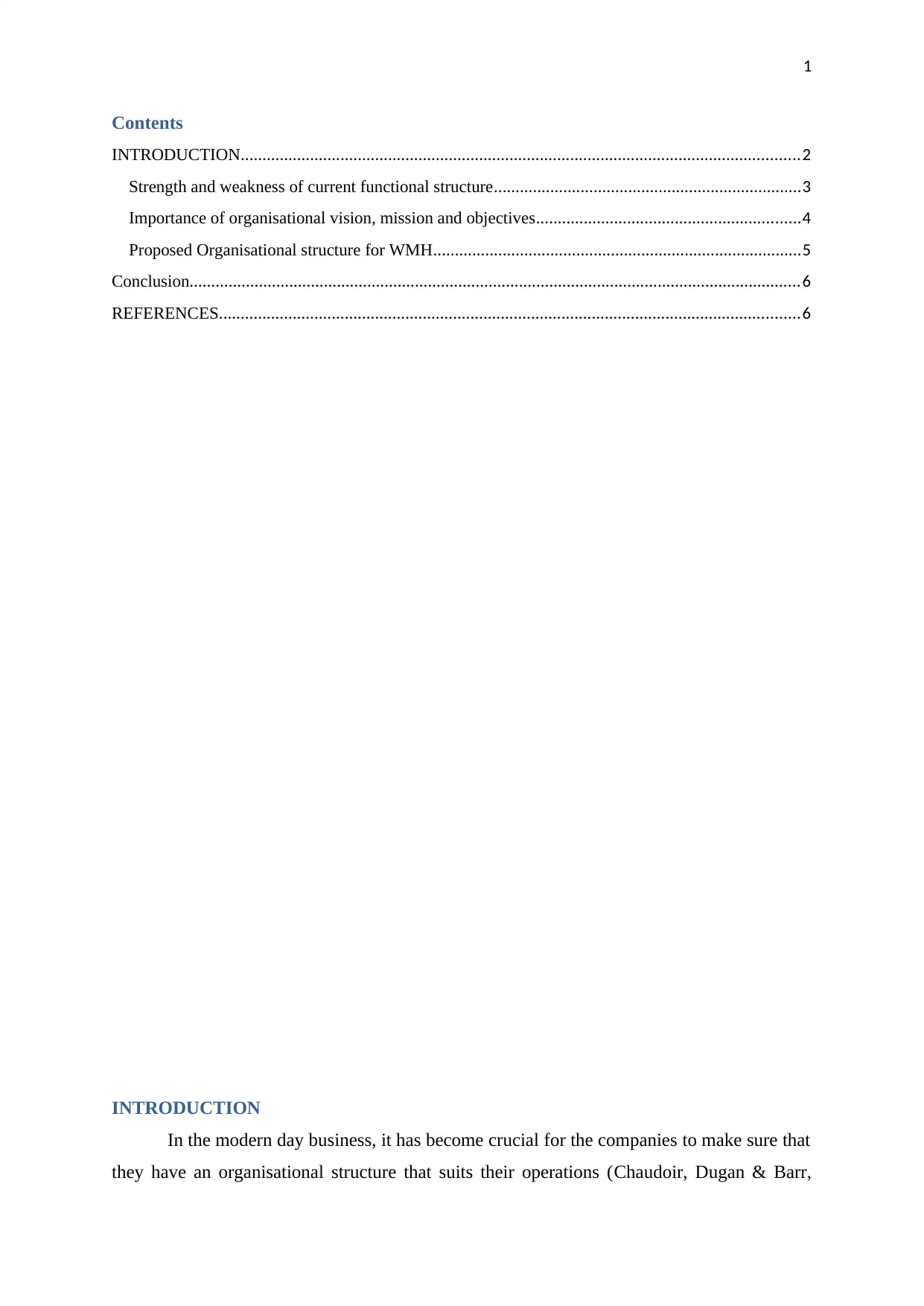
1
Contents
INTRODUCTION.................................................................................................................................2
Strength and weakness of current functional structure.......................................................................3
Importance of organisational vision, mission and objectives.............................................................4
Proposed Organisational structure for WMH.....................................................................................5
Conclusion.............................................................................................................................................6
REFERENCES......................................................................................................................................6
INTRODUCTION
In the modern day business, it has become crucial for the companies to make sure that
they have an organisational structure that suits their operations (Chaudoir, Dugan & Barr,
Contents
INTRODUCTION.................................................................................................................................2
Strength and weakness of current functional structure.......................................................................3
Importance of organisational vision, mission and objectives.............................................................4
Proposed Organisational structure for WMH.....................................................................................5
Conclusion.............................................................................................................................................6
REFERENCES......................................................................................................................................6
INTRODUCTION
In the modern day business, it has become crucial for the companies to make sure that
they have an organisational structure that suits their operations (Chaudoir, Dugan & Barr,
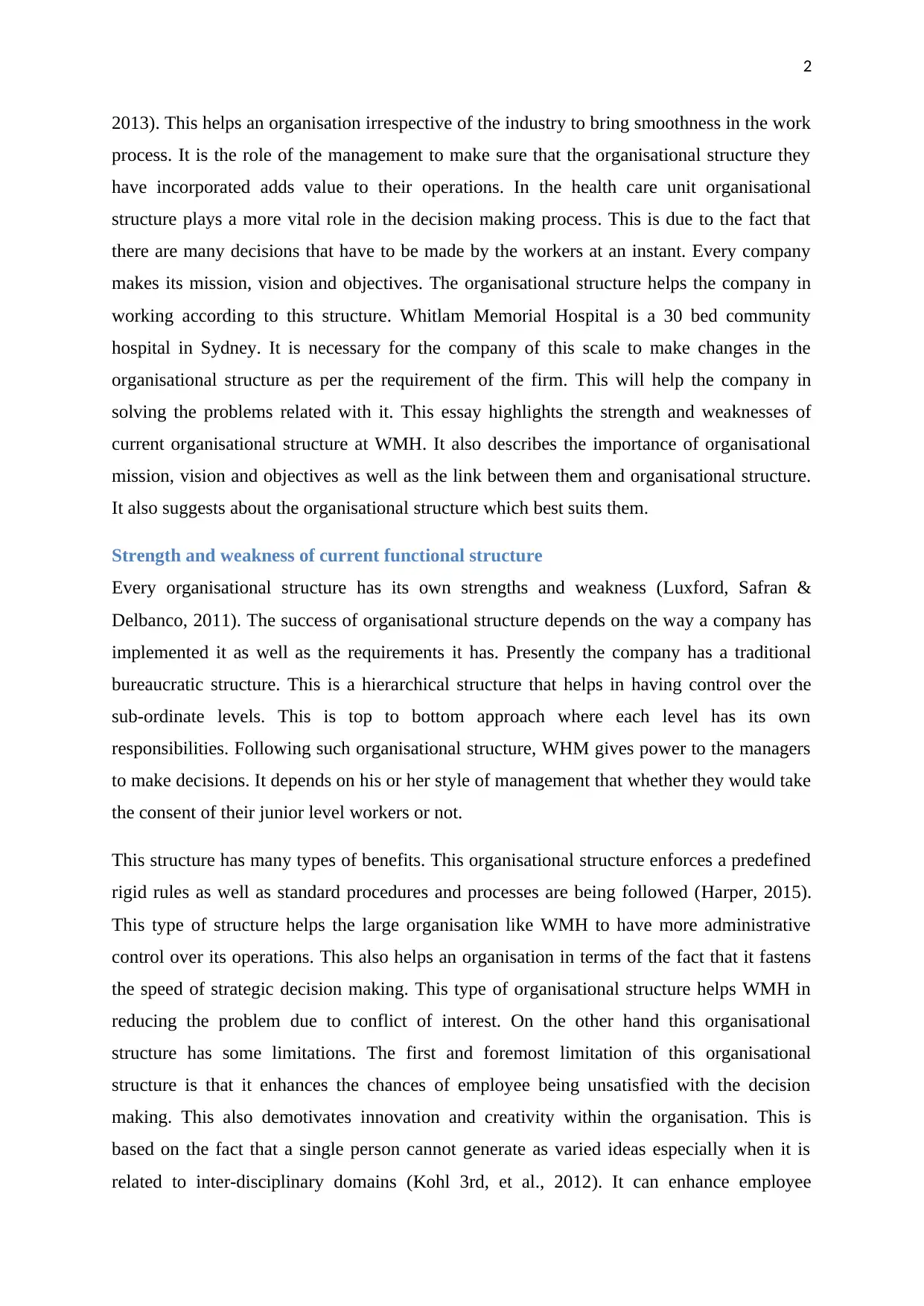
2
2013). This helps an organisation irrespective of the industry to bring smoothness in the work
process. It is the role of the management to make sure that the organisational structure they
have incorporated adds value to their operations. In the health care unit organisational
structure plays a more vital role in the decision making process. This is due to the fact that
there are many decisions that have to be made by the workers at an instant. Every company
makes its mission, vision and objectives. The organisational structure helps the company in
working according to this structure. Whitlam Memorial Hospital is a 30 bed community
hospital in Sydney. It is necessary for the company of this scale to make changes in the
organisational structure as per the requirement of the firm. This will help the company in
solving the problems related with it. This essay highlights the strength and weaknesses of
current organisational structure at WMH. It also describes the importance of organisational
mission, vision and objectives as well as the link between them and organisational structure.
It also suggests about the organisational structure which best suits them.
Strength and weakness of current functional structure
Every organisational structure has its own strengths and weakness (Luxford, Safran &
Delbanco, 2011). The success of organisational structure depends on the way a company has
implemented it as well as the requirements it has. Presently the company has a traditional
bureaucratic structure. This is a hierarchical structure that helps in having control over the
sub-ordinate levels. This is top to bottom approach where each level has its own
responsibilities. Following such organisational structure, WHM gives power to the managers
to make decisions. It depends on his or her style of management that whether they would take
the consent of their junior level workers or not.
This structure has many types of benefits. This organisational structure enforces a predefined
rigid rules as well as standard procedures and processes are being followed (Harper, 2015).
This type of structure helps the large organisation like WMH to have more administrative
control over its operations. This also helps an organisation in terms of the fact that it fastens
the speed of strategic decision making. This type of organisational structure helps WMH in
reducing the problem due to conflict of interest. On the other hand this organisational
structure has some limitations. The first and foremost limitation of this organisational
structure is that it enhances the chances of employee being unsatisfied with the decision
making. This also demotivates innovation and creativity within the organisation. This is
based on the fact that a single person cannot generate as varied ideas especially when it is
related to inter-disciplinary domains (Kohl 3rd, et al., 2012). It can enhance employee
2013). This helps an organisation irrespective of the industry to bring smoothness in the work
process. It is the role of the management to make sure that the organisational structure they
have incorporated adds value to their operations. In the health care unit organisational
structure plays a more vital role in the decision making process. This is due to the fact that
there are many decisions that have to be made by the workers at an instant. Every company
makes its mission, vision and objectives. The organisational structure helps the company in
working according to this structure. Whitlam Memorial Hospital is a 30 bed community
hospital in Sydney. It is necessary for the company of this scale to make changes in the
organisational structure as per the requirement of the firm. This will help the company in
solving the problems related with it. This essay highlights the strength and weaknesses of
current organisational structure at WMH. It also describes the importance of organisational
mission, vision and objectives as well as the link between them and organisational structure.
It also suggests about the organisational structure which best suits them.
Strength and weakness of current functional structure
Every organisational structure has its own strengths and weakness (Luxford, Safran &
Delbanco, 2011). The success of organisational structure depends on the way a company has
implemented it as well as the requirements it has. Presently the company has a traditional
bureaucratic structure. This is a hierarchical structure that helps in having control over the
sub-ordinate levels. This is top to bottom approach where each level has its own
responsibilities. Following such organisational structure, WHM gives power to the managers
to make decisions. It depends on his or her style of management that whether they would take
the consent of their junior level workers or not.
This structure has many types of benefits. This organisational structure enforces a predefined
rigid rules as well as standard procedures and processes are being followed (Harper, 2015).
This type of structure helps the large organisation like WMH to have more administrative
control over its operations. This also helps an organisation in terms of the fact that it fastens
the speed of strategic decision making. This type of organisational structure helps WMH in
reducing the problem due to conflict of interest. On the other hand this organisational
structure has some limitations. The first and foremost limitation of this organisational
structure is that it enhances the chances of employee being unsatisfied with the decision
making. This also demotivates innovation and creativity within the organisation. This is
based on the fact that a single person cannot generate as varied ideas especially when it is
related to inter-disciplinary domains (Kohl 3rd, et al., 2012). It can enhance employee
⊘ This is a preview!⊘
Do you want full access?
Subscribe today to unlock all pages.

Trusted by 1+ million students worldwide
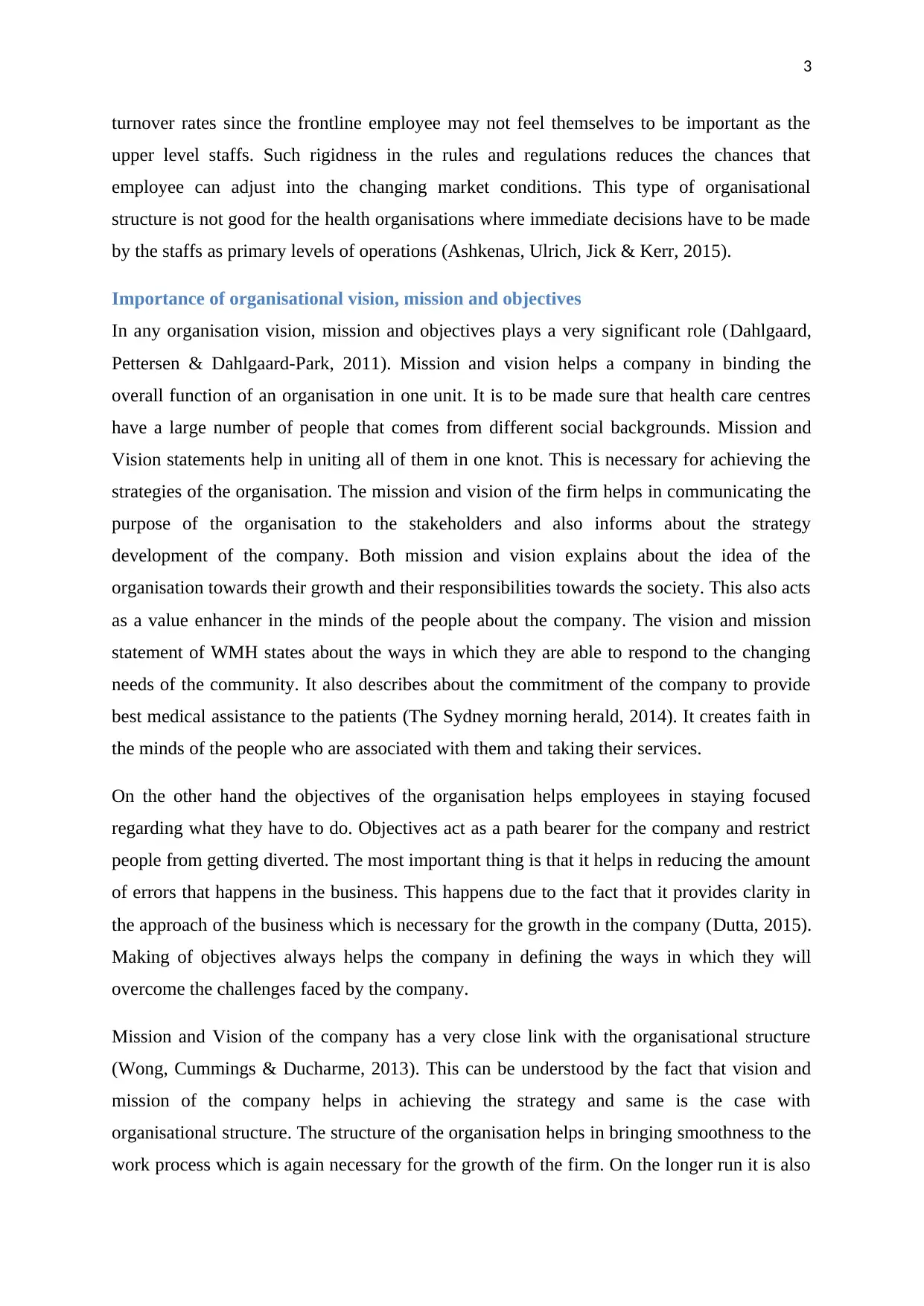
3
turnover rates since the frontline employee may not feel themselves to be important as the
upper level staffs. Such rigidness in the rules and regulations reduces the chances that
employee can adjust into the changing market conditions. This type of organisational
structure is not good for the health organisations where immediate decisions have to be made
by the staffs as primary levels of operations (Ashkenas, Ulrich, Jick & Kerr, 2015).
Importance of organisational vision, mission and objectives
In any organisation vision, mission and objectives plays a very significant role (Dahlgaard,
Pettersen & Dahlgaard-Park, 2011). Mission and vision helps a company in binding the
overall function of an organisation in one unit. It is to be made sure that health care centres
have a large number of people that comes from different social backgrounds. Mission and
Vision statements help in uniting all of them in one knot. This is necessary for achieving the
strategies of the organisation. The mission and vision of the firm helps in communicating the
purpose of the organisation to the stakeholders and also informs about the strategy
development of the company. Both mission and vision explains about the idea of the
organisation towards their growth and their responsibilities towards the society. This also acts
as a value enhancer in the minds of the people about the company. The vision and mission
statement of WMH states about the ways in which they are able to respond to the changing
needs of the community. It also describes about the commitment of the company to provide
best medical assistance to the patients (The Sydney morning herald, 2014). It creates faith in
the minds of the people who are associated with them and taking their services.
On the other hand the objectives of the organisation helps employees in staying focused
regarding what they have to do. Objectives act as a path bearer for the company and restrict
people from getting diverted. The most important thing is that it helps in reducing the amount
of errors that happens in the business. This happens due to the fact that it provides clarity in
the approach of the business which is necessary for the growth in the company (Dutta, 2015).
Making of objectives always helps the company in defining the ways in which they will
overcome the challenges faced by the company.
Mission and Vision of the company has a very close link with the organisational structure
(Wong, Cummings & Ducharme, 2013). This can be understood by the fact that vision and
mission of the company helps in achieving the strategy and same is the case with
organisational structure. The structure of the organisation helps in bringing smoothness to the
work process which is again necessary for the growth of the firm. On the longer run it is also
turnover rates since the frontline employee may not feel themselves to be important as the
upper level staffs. Such rigidness in the rules and regulations reduces the chances that
employee can adjust into the changing market conditions. This type of organisational
structure is not good for the health organisations where immediate decisions have to be made
by the staffs as primary levels of operations (Ashkenas, Ulrich, Jick & Kerr, 2015).
Importance of organisational vision, mission and objectives
In any organisation vision, mission and objectives plays a very significant role (Dahlgaard,
Pettersen & Dahlgaard-Park, 2011). Mission and vision helps a company in binding the
overall function of an organisation in one unit. It is to be made sure that health care centres
have a large number of people that comes from different social backgrounds. Mission and
Vision statements help in uniting all of them in one knot. This is necessary for achieving the
strategies of the organisation. The mission and vision of the firm helps in communicating the
purpose of the organisation to the stakeholders and also informs about the strategy
development of the company. Both mission and vision explains about the idea of the
organisation towards their growth and their responsibilities towards the society. This also acts
as a value enhancer in the minds of the people about the company. The vision and mission
statement of WMH states about the ways in which they are able to respond to the changing
needs of the community. It also describes about the commitment of the company to provide
best medical assistance to the patients (The Sydney morning herald, 2014). It creates faith in
the minds of the people who are associated with them and taking their services.
On the other hand the objectives of the organisation helps employees in staying focused
regarding what they have to do. Objectives act as a path bearer for the company and restrict
people from getting diverted. The most important thing is that it helps in reducing the amount
of errors that happens in the business. This happens due to the fact that it provides clarity in
the approach of the business which is necessary for the growth in the company (Dutta, 2015).
Making of objectives always helps the company in defining the ways in which they will
overcome the challenges faced by the company.
Mission and Vision of the company has a very close link with the organisational structure
(Wong, Cummings & Ducharme, 2013). This can be understood by the fact that vision and
mission of the company helps in achieving the strategy and same is the case with
organisational structure. The structure of the organisation helps in bringing smoothness to the
work process which is again necessary for the growth of the firm. On the longer run it is also
Paraphrase This Document
Need a fresh take? Get an instant paraphrase of this document with our AI Paraphraser
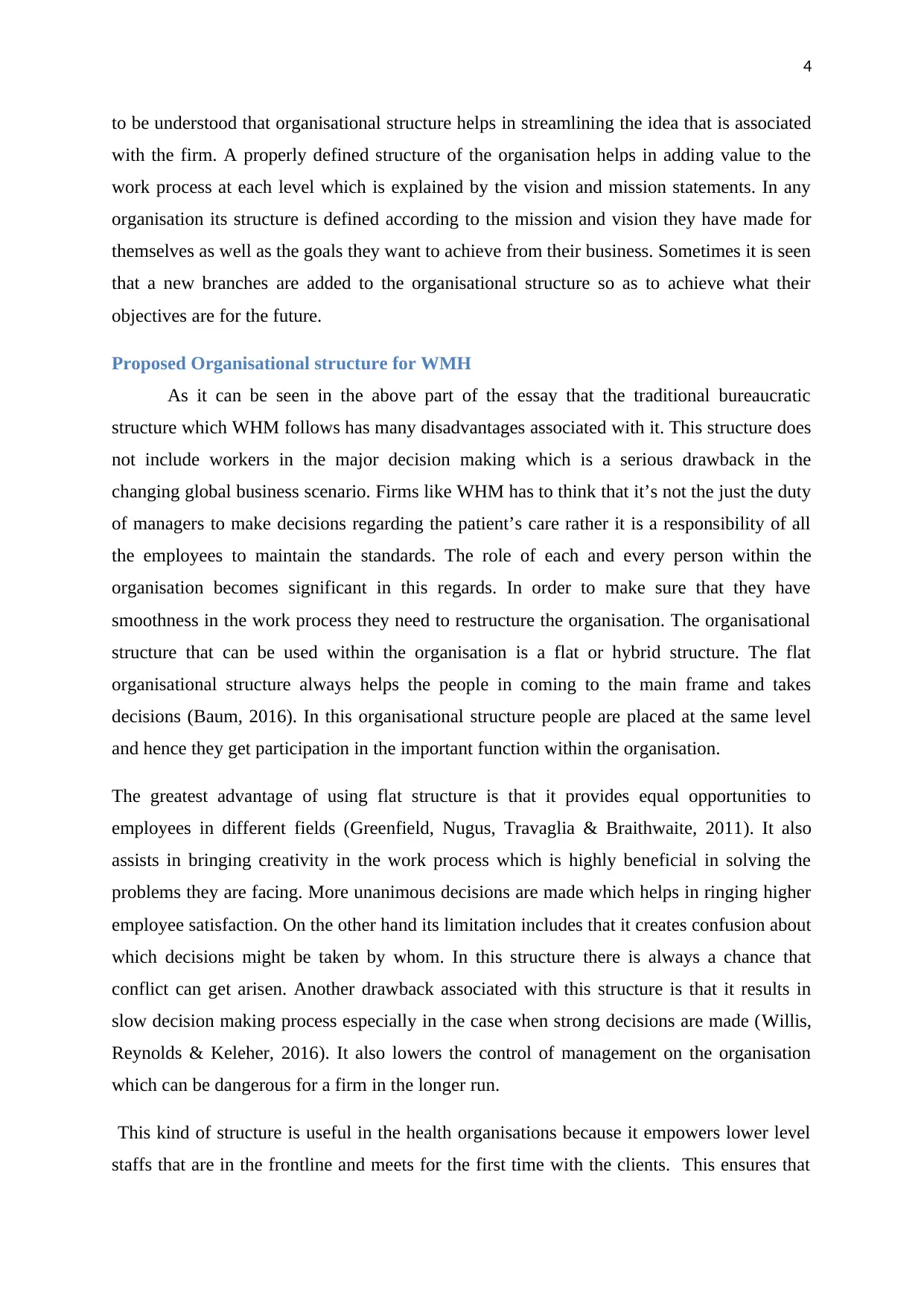
4
to be understood that organisational structure helps in streamlining the idea that is associated
with the firm. A properly defined structure of the organisation helps in adding value to the
work process at each level which is explained by the vision and mission statements. In any
organisation its structure is defined according to the mission and vision they have made for
themselves as well as the goals they want to achieve from their business. Sometimes it is seen
that a new branches are added to the organisational structure so as to achieve what their
objectives are for the future.
Proposed Organisational structure for WMH
As it can be seen in the above part of the essay that the traditional bureaucratic
structure which WHM follows has many disadvantages associated with it. This structure does
not include workers in the major decision making which is a serious drawback in the
changing global business scenario. Firms like WHM has to think that it’s not the just the duty
of managers to make decisions regarding the patient’s care rather it is a responsibility of all
the employees to maintain the standards. The role of each and every person within the
organisation becomes significant in this regards. In order to make sure that they have
smoothness in the work process they need to restructure the organisation. The organisational
structure that can be used within the organisation is a flat or hybrid structure. The flat
organisational structure always helps the people in coming to the main frame and takes
decisions (Baum, 2016). In this organisational structure people are placed at the same level
and hence they get participation in the important function within the organisation.
The greatest advantage of using flat structure is that it provides equal opportunities to
employees in different fields (Greenfield, Nugus, Travaglia & Braithwaite, 2011). It also
assists in bringing creativity in the work process which is highly beneficial in solving the
problems they are facing. More unanimous decisions are made which helps in ringing higher
employee satisfaction. On the other hand its limitation includes that it creates confusion about
which decisions might be taken by whom. In this structure there is always a chance that
conflict can get arisen. Another drawback associated with this structure is that it results in
slow decision making process especially in the case when strong decisions are made (Willis,
Reynolds & Keleher, 2016). It also lowers the control of management on the organisation
which can be dangerous for a firm in the longer run.
This kind of structure is useful in the health organisations because it empowers lower level
staffs that are in the frontline and meets for the first time with the clients. This ensures that
to be understood that organisational structure helps in streamlining the idea that is associated
with the firm. A properly defined structure of the organisation helps in adding value to the
work process at each level which is explained by the vision and mission statements. In any
organisation its structure is defined according to the mission and vision they have made for
themselves as well as the goals they want to achieve from their business. Sometimes it is seen
that a new branches are added to the organisational structure so as to achieve what their
objectives are for the future.
Proposed Organisational structure for WMH
As it can be seen in the above part of the essay that the traditional bureaucratic
structure which WHM follows has many disadvantages associated with it. This structure does
not include workers in the major decision making which is a serious drawback in the
changing global business scenario. Firms like WHM has to think that it’s not the just the duty
of managers to make decisions regarding the patient’s care rather it is a responsibility of all
the employees to maintain the standards. The role of each and every person within the
organisation becomes significant in this regards. In order to make sure that they have
smoothness in the work process they need to restructure the organisation. The organisational
structure that can be used within the organisation is a flat or hybrid structure. The flat
organisational structure always helps the people in coming to the main frame and takes
decisions (Baum, 2016). In this organisational structure people are placed at the same level
and hence they get participation in the important function within the organisation.
The greatest advantage of using flat structure is that it provides equal opportunities to
employees in different fields (Greenfield, Nugus, Travaglia & Braithwaite, 2011). It also
assists in bringing creativity in the work process which is highly beneficial in solving the
problems they are facing. More unanimous decisions are made which helps in ringing higher
employee satisfaction. On the other hand its limitation includes that it creates confusion about
which decisions might be taken by whom. In this structure there is always a chance that
conflict can get arisen. Another drawback associated with this structure is that it results in
slow decision making process especially in the case when strong decisions are made (Willis,
Reynolds & Keleher, 2016). It also lowers the control of management on the organisation
which can be dangerous for a firm in the longer run.
This kind of structure is useful in the health organisations because it empowers lower level
staffs that are in the frontline and meets for the first time with the clients. This ensures that
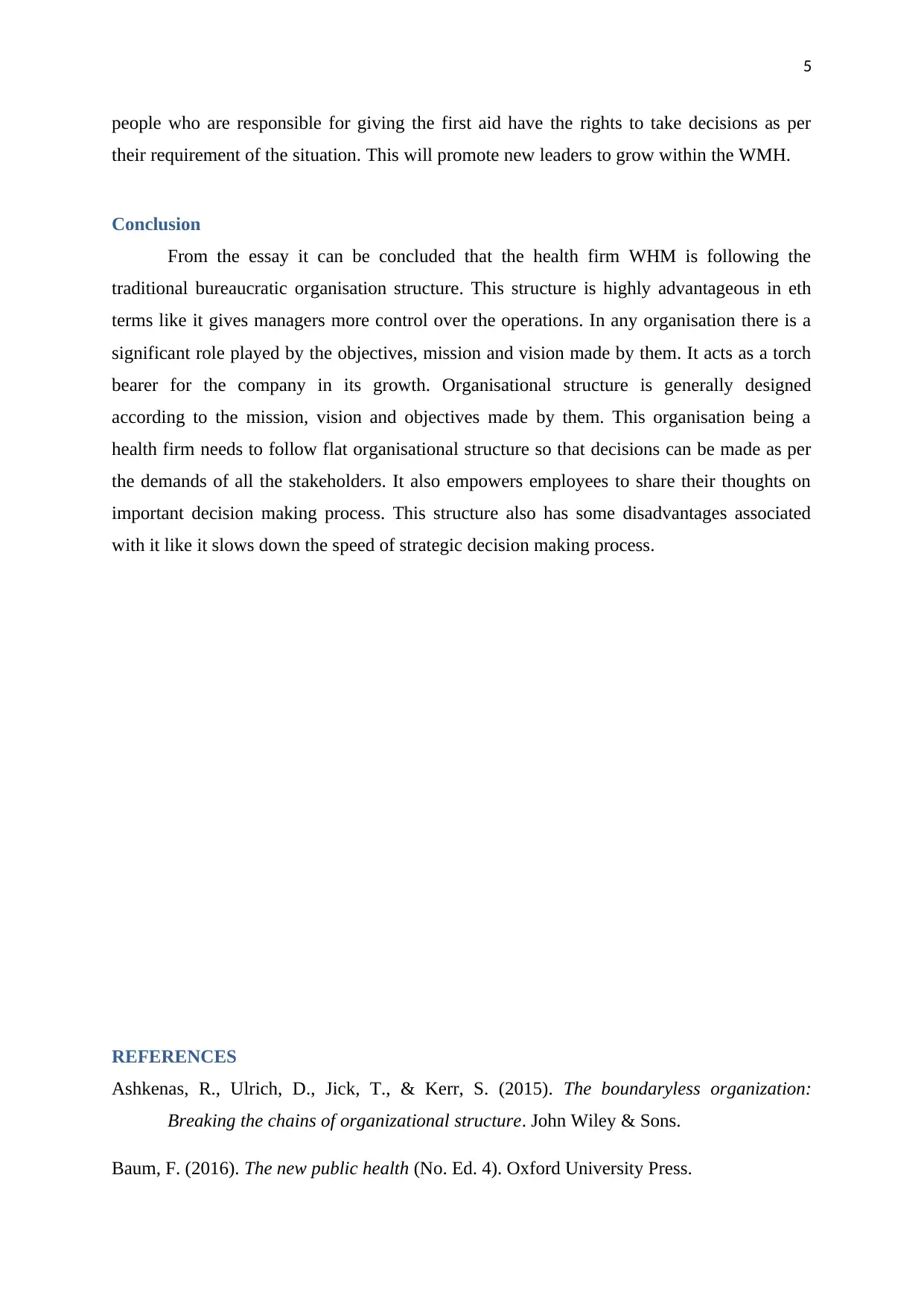
5
people who are responsible for giving the first aid have the rights to take decisions as per
their requirement of the situation. This will promote new leaders to grow within the WMH.
Conclusion
From the essay it can be concluded that the health firm WHM is following the
traditional bureaucratic organisation structure. This structure is highly advantageous in eth
terms like it gives managers more control over the operations. In any organisation there is a
significant role played by the objectives, mission and vision made by them. It acts as a torch
bearer for the company in its growth. Organisational structure is generally designed
according to the mission, vision and objectives made by them. This organisation being a
health firm needs to follow flat organisational structure so that decisions can be made as per
the demands of all the stakeholders. It also empowers employees to share their thoughts on
important decision making process. This structure also has some disadvantages associated
with it like it slows down the speed of strategic decision making process.
REFERENCES
Ashkenas, R., Ulrich, D., Jick, T., & Kerr, S. (2015). The boundaryless organization:
Breaking the chains of organizational structure. John Wiley & Sons.
Baum, F. (2016). The new public health (No. Ed. 4). Oxford University Press.
people who are responsible for giving the first aid have the rights to take decisions as per
their requirement of the situation. This will promote new leaders to grow within the WMH.
Conclusion
From the essay it can be concluded that the health firm WHM is following the
traditional bureaucratic organisation structure. This structure is highly advantageous in eth
terms like it gives managers more control over the operations. In any organisation there is a
significant role played by the objectives, mission and vision made by them. It acts as a torch
bearer for the company in its growth. Organisational structure is generally designed
according to the mission, vision and objectives made by them. This organisation being a
health firm needs to follow flat organisational structure so that decisions can be made as per
the demands of all the stakeholders. It also empowers employees to share their thoughts on
important decision making process. This structure also has some disadvantages associated
with it like it slows down the speed of strategic decision making process.
REFERENCES
Ashkenas, R., Ulrich, D., Jick, T., & Kerr, S. (2015). The boundaryless organization:
Breaking the chains of organizational structure. John Wiley & Sons.
Baum, F. (2016). The new public health (No. Ed. 4). Oxford University Press.
⊘ This is a preview!⊘
Do you want full access?
Subscribe today to unlock all pages.

Trusted by 1+ million students worldwide
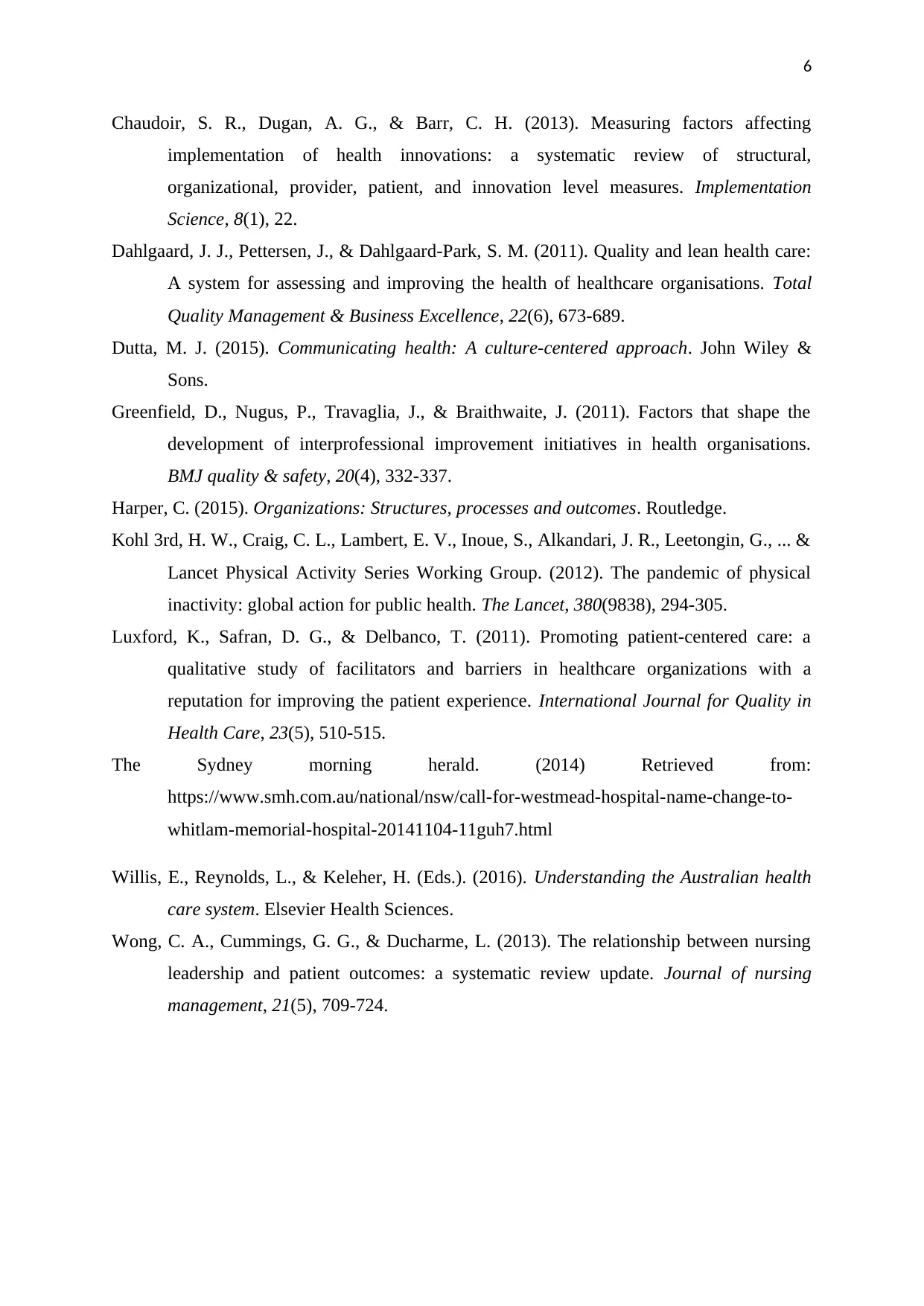
6
Chaudoir, S. R., Dugan, A. G., & Barr, C. H. (2013). Measuring factors affecting
implementation of health innovations: a systematic review of structural,
organizational, provider, patient, and innovation level measures. Implementation
Science, 8(1), 22.
Dahlgaard, J. J., Pettersen, J., & Dahlgaard-Park, S. M. (2011). Quality and lean health care:
A system for assessing and improving the health of healthcare organisations. Total
Quality Management & Business Excellence, 22(6), 673-689.
Dutta, M. J. (2015). Communicating health: A culture-centered approach. John Wiley &
Sons.
Greenfield, D., Nugus, P., Travaglia, J., & Braithwaite, J. (2011). Factors that shape the
development of interprofessional improvement initiatives in health organisations.
BMJ quality & safety, 20(4), 332-337.
Harper, C. (2015). Organizations: Structures, processes and outcomes. Routledge.
Kohl 3rd, H. W., Craig, C. L., Lambert, E. V., Inoue, S., Alkandari, J. R., Leetongin, G., ... &
Lancet Physical Activity Series Working Group. (2012). The pandemic of physical
inactivity: global action for public health. The Lancet, 380(9838), 294-305.
Luxford, K., Safran, D. G., & Delbanco, T. (2011). Promoting patient-centered care: a
qualitative study of facilitators and barriers in healthcare organizations with a
reputation for improving the patient experience. International Journal for Quality in
Health Care, 23(5), 510-515.
The Sydney morning herald. (2014) Retrieved from:
https://www.smh.com.au/national/nsw/call-for-westmead-hospital-name-change-to-
whitlam-memorial-hospital-20141104-11guh7.html
Willis, E., Reynolds, L., & Keleher, H. (Eds.). (2016). Understanding the Australian health
care system. Elsevier Health Sciences.
Wong, C. A., Cummings, G. G., & Ducharme, L. (2013). The relationship between nursing
leadership and patient outcomes: a systematic review update. Journal of nursing
management, 21(5), 709-724.
Chaudoir, S. R., Dugan, A. G., & Barr, C. H. (2013). Measuring factors affecting
implementation of health innovations: a systematic review of structural,
organizational, provider, patient, and innovation level measures. Implementation
Science, 8(1), 22.
Dahlgaard, J. J., Pettersen, J., & Dahlgaard-Park, S. M. (2011). Quality and lean health care:
A system for assessing and improving the health of healthcare organisations. Total
Quality Management & Business Excellence, 22(6), 673-689.
Dutta, M. J. (2015). Communicating health: A culture-centered approach. John Wiley &
Sons.
Greenfield, D., Nugus, P., Travaglia, J., & Braithwaite, J. (2011). Factors that shape the
development of interprofessional improvement initiatives in health organisations.
BMJ quality & safety, 20(4), 332-337.
Harper, C. (2015). Organizations: Structures, processes and outcomes. Routledge.
Kohl 3rd, H. W., Craig, C. L., Lambert, E. V., Inoue, S., Alkandari, J. R., Leetongin, G., ... &
Lancet Physical Activity Series Working Group. (2012). The pandemic of physical
inactivity: global action for public health. The Lancet, 380(9838), 294-305.
Luxford, K., Safran, D. G., & Delbanco, T. (2011). Promoting patient-centered care: a
qualitative study of facilitators and barriers in healthcare organizations with a
reputation for improving the patient experience. International Journal for Quality in
Health Care, 23(5), 510-515.
The Sydney morning herald. (2014) Retrieved from:
https://www.smh.com.au/national/nsw/call-for-westmead-hospital-name-change-to-
whitlam-memorial-hospital-20141104-11guh7.html
Willis, E., Reynolds, L., & Keleher, H. (Eds.). (2016). Understanding the Australian health
care system. Elsevier Health Sciences.
Wong, C. A., Cummings, G. G., & Ducharme, L. (2013). The relationship between nursing
leadership and patient outcomes: a systematic review update. Journal of nursing
management, 21(5), 709-724.
Paraphrase This Document
Need a fresh take? Get an instant paraphrase of this document with our AI Paraphraser

7
1 out of 8
Related Documents
Your All-in-One AI-Powered Toolkit for Academic Success.
+13062052269
info@desklib.com
Available 24*7 on WhatsApp / Email
![[object Object]](/_next/static/media/star-bottom.7253800d.svg)
Unlock your academic potential
Copyright © 2020–2025 A2Z Services. All Rights Reserved. Developed and managed by ZUCOL.





